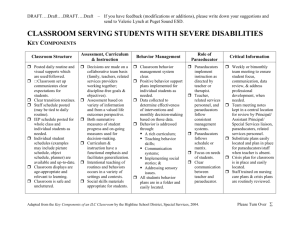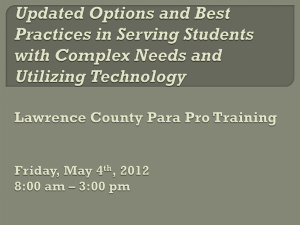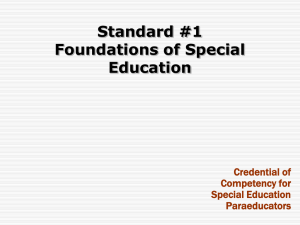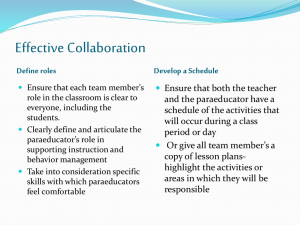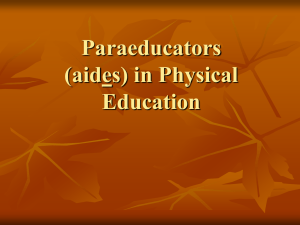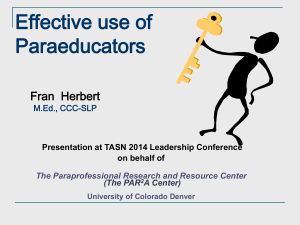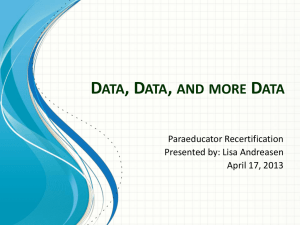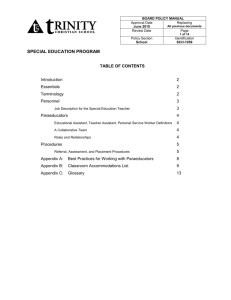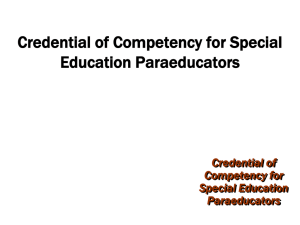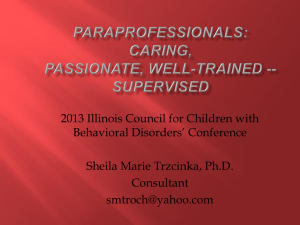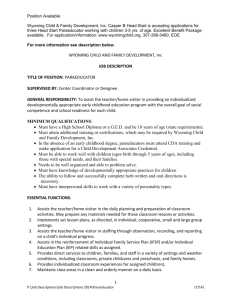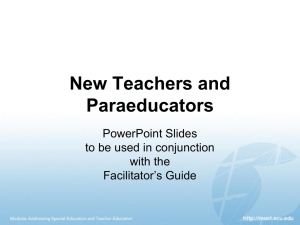Paraprofessional Time Management Tool
advertisement
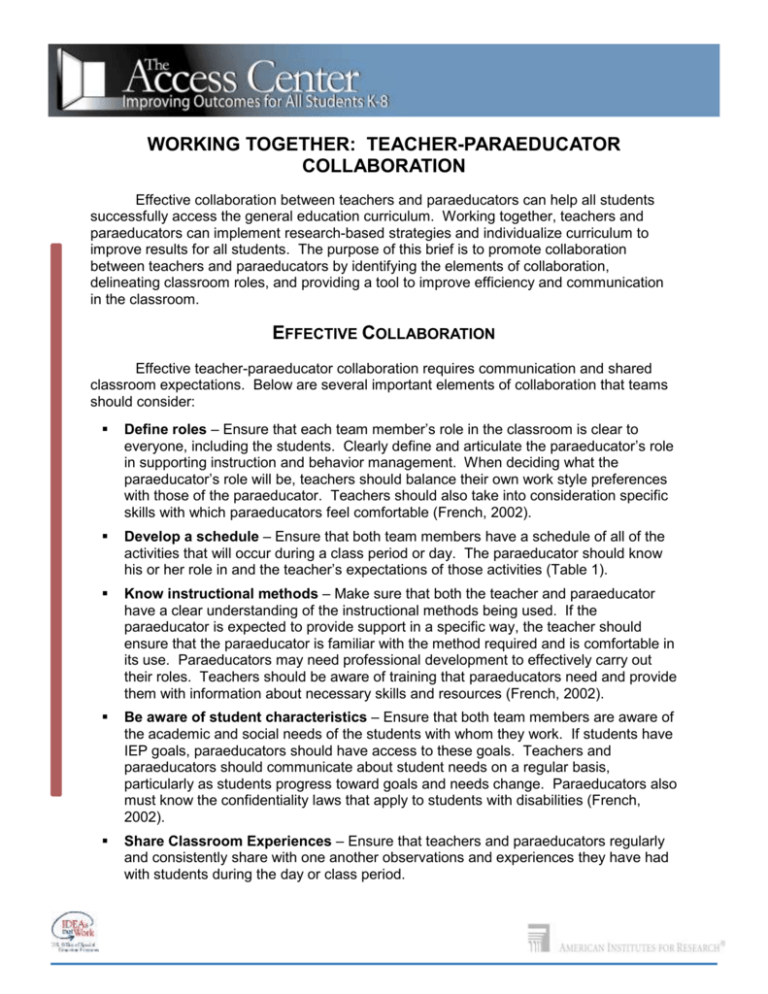
WORKING TOGETHER: TEACHER-PARAEDUCATOR COLLABORATION Effective collaboration between teachers and paraeducators can help all students successfully access the general education curriculum. Working together, teachers and paraeducators can implement research-based strategies and individualize curriculum to improve results for all students. The purpose of this brief is to promote collaboration between teachers and paraeducators by identifying the elements of collaboration, delineating classroom roles, and providing a tool to improve efficiency and communication in the classroom. EFFECTIVE COLLABORATION Effective teacher-paraeducator collaboration requires communication and shared classroom expectations. Below are several important elements of collaboration that teams should consider: Define roles – Ensure that each team member’s role in the classroom is clear to everyone, including the students. Clearly define and articulate the paraeducator’s role in supporting instruction and behavior management. When deciding what the paraeducator’s role will be, teachers should balance their own work style preferences with those of the paraeducator. Teachers should also take into consideration specific skills with which paraeducators feel comfortable (French, 2002). Develop a schedule – Ensure that both team members have a schedule of all of the activities that will occur during a class period or day. The paraeducator should know his or her role in and the teacher’s expectations of those activities (Table 1). Know instructional methods – Make sure that both the teacher and paraeducator have a clear understanding of the instructional methods being used. If the paraeducator is expected to provide support in a specific way, the teacher should ensure that the paraeducator is familiar with the method required and is comfortable in its use. Paraeducators may need professional development to effectively carry out their roles. Teachers should be aware of training that paraeducators need and provide them with information about necessary skills and resources (French, 2002). Be aware of student characteristics – Ensure that both team members are aware of the academic and social needs of the students with whom they work. If students have IEP goals, paraeducators should have access to these goals. Teachers and paraeducators should communicate about student needs on a regular basis, particularly as students progress toward goals and needs change. Paraeducators also must know the confidentiality laws that apply to students with disabilities (French, 2002). Share Classroom Experiences – Ensure that teachers and paraeducators regularly and consistently share with one another observations and experiences they have had with students during the day or class period. Share Responsibility for Students – Make sure that both team members are working with all students equally. No students should spend a majority of their time working with only the paraeducator (Giangreco, 2003). Teachers and paraeducators should set a time to meet on a regular basis (Carroll, 2001). This time can be used to discuss students and classroom activities. Meeting regularly also provides paraeducators with an opportunity to ask questions, state concerns, and clarify issues. If one paraeducator is assigned to several teachers, it is beneficial to meet as a group, particularly if all teachers serve the same students. CLASSROOM ROLES A clear understanding of each team member’s role, coupled with ongoing communication, is vital to effective collaboration. The following chart provides guidance on each team member’s role and the areas of communication involved. Table 1: Roles and Responsibilities Teacher Role Paraeducator Role Areas of Communication Work with small groups Teachers provide of students on specific specific content and tasks, including review guidance about or re-teaching of curriculum, students, content and instructional materials Work with one student at a time to provide Paraeducators note intensive instruction or student progress and remediation on a give feedback to concept or skill teachers Instruction Plan all instruction, including small group activities1 Provide instruction in whole-class settings. Curriculum & Lesson Plan Development Develop all lesson Provide assistance in plans and instructional development of materials1 classroom activities, retrieval of materials, Ensure alignment with and coordination of standards, student activities needs, and IEPs Develop and guide Assist with the class-wide implementation of management plans for class-wide and behavior and classroom individual behavior structures management plans Develop and monitor Monitor hallways, study individual behavior hall, & other activities management plans outside normal class Classroom Management 1 Mutual review of lesson plan components prior to class Teachers provide guidance about specific instructional methods Teachers provide guidance about specific behavior management strategies & student characteristics Paraeducators note student progress & activities and give feedback to teachers Pickett (1999) 2/12/2016 Page 2 Teacher Role Accommodations & Modifications Assessment Paraeducator Role Areas of Communication Determine (with IEP Guided by teacher and Teachers guide team) proper IEP, provide paraeducators in the accommodations for appropriate use of specific students with accommodations to adaptations and ensure disabilities material (enlarged print, that paraeducators are taking notes, reading aware of IEP goals and Incorporate material aloud) adaptations accommodations into all lesson plans Paraeducators provide feedback about student Develop modified progress and success of materials adaptations Determine, create, and Assist in the Teacher provides administer appropriate administration of guidance about the formal and informal assessments content and assessments implementation of all Implement assessments Determine accommodations for modifications and assessment Paraeducator provides accommodations to be Collect anecdotal feedback about student used for formal progress student information on assessments a regular basis Mutual conversations Use assessment results about anecdotal to inform future information and informal planning and curriculum student data collection development TEACHER-PARAEDUCATOR PLANNING TOOL The table on the following page presents a time management tool, which provides a quick and easy way for teacher-paraeducator teams to collaborate in the classroom. The first column of the tool organizes the day by class period. The second column further breaks down the day into specific times or events during each class period. The next five columns are the five days of the week including lines delineating the class period and a specific time during that period. The task key at the bottom provides teachers with an efficient way to assign a specific task during a time or event to a student or group of students by simply entering in the task number and the name(s) of the student(s). Teachers and paraeducators can modify the list of tasks each week. Following the sample tool is a blank tool which can be easily printed out or copied to another document for use in the classroom. Teams may want to consider printing out the tool, laminating it, and implementing it with an erasable pen so it can be easily modified and re-used each week. Further, rows and columns can be easily adapted and customized to meet the specific needs of teacher-paraeducator teams. 2/12/2016 Page 3 Table 2: Sample Teacher-Paraeducator Planning Tool Teacher: John Doe Class: History Paraeducator: Mary Smith Assigned Student(s) & Task 8-8:15 8:15-8:30 8:30-8:45 8:45-9 Monday All – 4, 3 Tuesday (group work) J. Doe, B. Roy , J. Port & C. John – 1 (pair work) J. Porter & C. John - 1 (ind. work)All - 5 P. Rich & M. Barnes -6 (lecture) C. John - 2 (lecture) C. John - 2 All – 5 All – 4, 3 8-8:30 (group work) D. Clort – 1 (lecture) C. James 2 (ind. work) All - 5 8:45-9 Thursday (ind. work) D. Close – 6, 7:55 – 8 am 8:30-45 Wednesday All – 4 Friday (group work) All – 4 R. Clark, J. Doe, P. Brown - 5 (ind. work) C. John -7 (ind. work) All - 5 A. Smith, D. Jones, & L. Lee - 6 Period 6 Period 4/History 1 Period 1/History 200 Time Prior to 8 am class Week: February 8-11, 2005 Task Key 1 – Work with student(s) to re-teach longitude/ latitude, use text p.54-55 2 – During lecture, provide note-taking support for student 3 – Enlarge print on longitude/latitude worksheet – make 5 copies 4 – Positive reinforcements (stamp notebooks) for students entering and beginning warmup 5 – Monitor student(s) – provide help/answer questions as needed 6 – Supervise student work on Excel spreadsheet project 7 – Sit with student, assist on ind. work 2/12/2016 Page 4 Teacher: Class: Paraeducator: Time Week: Assigned Student(s) & Task Monday Tuesday Wednesday Thursday Friday Task Key 1 – _________________________________ 5 – _________________________________ 9 – ________________________________ 2 – _________________________________ 6 – _________________________________ 10 – ________________________________ 3 – _________________________________ 7 – _________________________________ 11 – ________________________________ 4 – _________________________________ 8 – _________________________________ 12 – ________________________________ 2/12/2016 Page 5 Resources Gerlach, K. (2001). Let’s Team Up! A Checklist for Paraeducators, Teachers, and Principals. Washington, D.C.: National Education Association. Northeast Regional Resource Center (www.wested.org/nerrc/paraprofessionals.htm) National Resource Center for Paraprofessionals (www.nrcpara.org) The Para Center at the University of Colorado at Denver (www.paracenter.org) Email: info@paracenter.org Phone: 303.556.6464 Paraeducator Support (http://www.uvm.edu/%7Ecdci/parasupport/) and Paraeducator Training at the University of Vermont (http://www.uvm.edu/%7Ecdci/paraprep/) are companion projects designed to develop, implement and evaluate a model for effective use of paraeducators and improvement of training through model preservice and inservice programs. A Resource Guide for Integrating Teacher Aides into Lesson Plans (http://www.spannj.org/information/teacheraideslessons-ResourceGuide.doc) developed by Newark Public Schools provides a detailed overview of the requirements of NCLB, integrated lesson plans, behavior management plans, and collaboration tips. References Caroll, D. (2001). Considering paraeducator training, roles, and responsibilities. Teaching Exceptional Children, 34(2), 60-64. French, N. (2003). Managing paraeducators in your school. Thousand Oaks, CA: Corwin Press. French, N.K. (2002). Maximize paraprofessional services for students with learning disabilities. Intervention in School and Clinic, 38(1), 50-55. Giangreco, M. F. (2001). A guide to schoolwide planning for paraeducator supports. Center on Disability and Community Inclusion: University of Vermont. Retrieved Feb. 7, 2005 from http://www.uvm.edu/~cdci/parasupport/downloa ds/guide.pdf. Giangreco, M.F. (2003). Working with paraprofessionals. Educational Leadership, 61(2), 50-53. Montana Office of Public Instruction. (2004). Paraprofessional orientation guide. Retrieved Feb 14, 2005 from http://www.opi.state.mt.us/PDF/CSPD/ParaOrientMan.pdf. National Joint Committee on Learning Disabilities. (1999). Learning disabilities: Use of paraprofessionals. Asha 41. Retrieved 2/7/05 from http://www.ldonline.org/njcld/ paraprof298.html. 2/12/2016 Page 6 Pickett, A.L. (1999). Strengthening and Supporting Teacher/Provider-Paraeducator Teams: Guidelines for Paraeducator Roles, Supervision, and Preparation. For additional information on this or other topics, please contact The Access Center at accesscenter@air.org. The Access Center: Improving Outcomes for All Students K-8 The Access Center is a cooperative agreement (H326K020003) funded by the U.S. Department of Education, Office of Special Education Programs, awarded to the American Institutes for Research 1000 Thomas Jefferson St. NW, Washington, DC 20007 Ph: 202-403-5000 TTY: 877-334-3499 Fax: 202-403-5001 e-mail: accesscenter@air.org website: www.k8accesscenter.org This report was produced under U.S. Department of Education Grant # H326K020003 with the American Institutes for Research. Jane Hauser served as the project officer. The views expressed herein do not necessarily represent the positions or policies of the Department of Education. No official endorsement by the U.S. Department of Education of any product, commodity, service or enterprise mentioned in this publication is intended or should be inferred. 2/12/2016 Page 7
